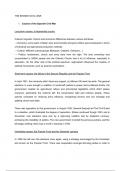THE SPANISH CIVIL WAR
1. Causes of the Spanish Civil War
Long-term causes: a fragmented country
Cultural, linguistic, historic and economic differences between various territories.
→ Economy: some parts of Spain were economically strong but others were backwards in terms
of industrial and agricultural production methods.
→ Culture: different cultural groups (Basques, Catalans, Galicians…)
→ Politics: landowners, church and army were from the right. The land ownership was
concentrated in 50000 people and the Catholic Church had a lot of influence, especially in
education. On the other side of the political spectrum, regionalism influenced the creation of
political movements, such as anarcho-syndicalism.
Short-term causes: the failure of the Second Republic and the Popular Front
In April 1931, the monarchy didn’t have any support, so Alfonso XIII went into exile. The general
elections in June brought a coalition of center-left parties to power, led by Manuel Azaña. His
government created an agricultural, labour and anti-clerical legislation which didn’t please
everyone, particularly the extreme left, the conservative right and ordinary people. These
policies consisted on reducing army influence, recognising divorce and civil marriage and
splitting church and state.
There was opposition to this government; in August 1932, General Sanjurjo led The Civil Guard
to a rebellion, which illustrated the degree of opposition. Strikes continued though 1933, and in
November new elections were won by a right-wing coalition (led by Alejandro Lerroux),
portraying the instability of politics. The new government inverted the previous policies, and the
left began striking; there was a revolt in Asturias in 1934.
Immediate causes: the Popular Front and the Generals’ uprising
In 1936 the left won the elections once again, using a strategy encouraged by the Comintern
and known as the Popular Front. There was cooperation amongst left-wing parties in order to
, avoid votes from splitting up. This was a defensive strategy inspired by the Nazi Germany
(where Hitler was able to win because of the instability on the left), designed to stop the extreme
right from taking control.
This, however, was a short-term solution, because the left parties didn’t have any agreements
that went beyond the elections (deep political and ideological differences). The parties agreed
on what they didn’t want but not on the policies they wanted to implement. In other words, the
Popular Front was a creation that challenged the idea of democracy, not putting faith in the
people.
In April 1936 Azaña was elevated to President and, understanding the threat of the Republic
posed by the Army, he sought to divide the military leadership. General Moda, Goded and
Franco were isolated from their bases, but that didn’t stop rebels from organizing a military
uprising.
The assassination of Calvo Sotelo (right-wing monarchist) on 13 July 1936 provided a valid
excuse for the military insurrection, which the Republican government wasn’t fast enough to
stop at the beginning. While there were plenty of left-wing organizations, most of them didn’t
have the tools necessary to combat, so the Republic became dependent on the Civil Guard,
which sided with different rivals depending on the territory.
In Madrid and the east of Spain, the government maintained control, and Barcelona, after
General Goded surrendered, became the heart of loyalist Spain. The government, in other
words, only kept control in places where they would accept external help, or in territories where
the army was poorly organized. As a form of central control, the government was weak.




